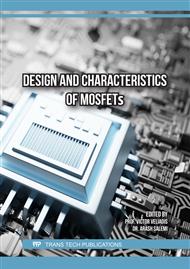p.7
p.13
p.21
p.29
p.39
p.47
p.53
p.59
p.65
A Novel Design of SiC High-Voltage Lateral PiN Diode for IC Application
Abstract:
With its excellent thermal conductivity, high critical breakdown field strength, and high temperature tolerance, Silicon Carbide (SiC) is widely used in the fabrication of power devices. In recent years, many vertical high-voltage SiC PiN diodes with superior performance have been reported. However, since the cathode-anode voltage in these devices is vertically blocked in the semiconductor, the on-chip isolation between the devices is difficult to achieve. For this reason, the vertical power device is typically employed for high power densities in single-device packages or power modules. In contrast, effective isolation between lateral high-voltage devices can be achieved by using isolation structures, which enables monolithic integration with lateral PiN diodes, transistors, and resistors to achieve control, routing, and power density regulation in smart power-integrated circuits (ICs). This work describes the design and fabrication process of a novel SiC high-voltage lateral PiN (HVLPN) diode with the addition of a lateral isolation structure with a thickness of 10 μm to achieve sufficient isolation between breakdown voltages and devices, as well as a solution for the deep etching of the SiC over 10 μm with a thick enough Hard Mask (HDM), which is required for the actual fabrication process.
Info:
Periodical:
Pages:
47-52
Citation:
Online since:
September 2025
Authors:
Permissions:
Share:
Citation:


